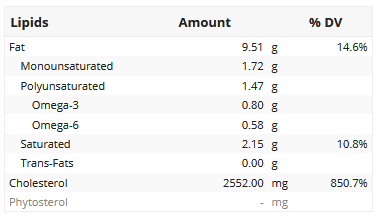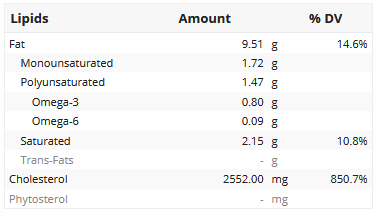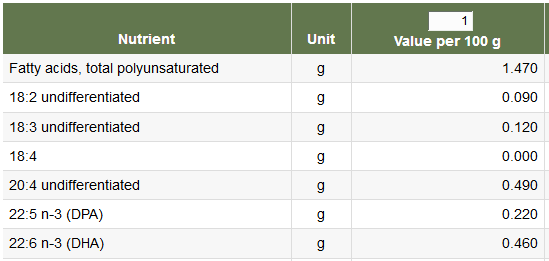Plant Foods and Animal Foods
I put this together to illustrate just how well plant foods and animal foods operate in synergy with one another. It's astonishing just how much they resemble two puzzle pieces.
Nutrient Report:
https://i.imgur.com/HeVl80c.png
Food Intake:
https://i.imgur.com/2527Ruh.png
Comments
-
BRBWaffles, from what you have posted so far I realize that you really know what you're doing !
 I am a beginer in nutrition and I dream to become like you.
I am a beginer in nutrition and I dream to become like you.
I see that you have different RDA's for some nutrients and even added some new ones. I want to learn more obout this. Can you point me to some good online resources ?I apologise for my misspellings, as English is not my native language.
-
I can't really point to any decent resources, no. Any changes I've made to the minimum values for any nutrient is the result of reading PubMed. It would be hard to compile several hundred research papers and send them to you, haha. But, I've added the nutrients: choline, lutein and zeaxanthin, retinol activity equivalents, gamma-tocopherol, and glycine.
My philosophy is that, by default, I'm completely agnostic about nutrition topics that are controversial. I go on to PubMed and I do my own research. So, I don't really care about saturated fat, cholesterol, red meat, processed meat, dietary carbohydrates in general, or dietary fat in general. I see absolutely zero evidence that any of these influence any sort of disease risk in the majority of the population. I find that once you become agnostic to those topics, or stop worrying about them, a nutrient dense diet is far more attainable. You get way more nutrition from 8g of liver, 50g of beef heart, and 3 eggs than you could ever hope to get from most plant foods by weight or calories, for example. But if one was scared of saturated fat or cholesterol, they'd probably avoid those extremely healthy foods.
I can't bombard you with research papers, but I can give you the skinny on each nutrient for which I have a custom minimum daily value:
Vitamin C
Lutein and Zeaxanthin
Retinol Activity Equivalents
Gamma-tocopherol
Vitamin K
Omega-6
Omega-3
Calcium
GlycineVitamin C - 90mg to 300mg
If you read the original research paper used to establish the 90mg DRI for vitamin C, you'll read in there that 300mg per day yielded the most robust antioxidant activity, but 90mg was enough to generate the minimum activity. So, I think the vitamin C DRI is set way too low.
Lutein and Zeaxanthin - NA to 6000mcg
In nearly every study I've ever read on lutein/zeaxanthin supplementation, a protective effect of 6000mcg per day was observed. Particularly against macular degeneration.
Retinol Activity Equivalents - NA to 1500mcg
The RAE is how much retinol (preformed vitamin A) you have after consuming carotenoids (precursor/provitamin A) and taking into account inherent conversion inefficiencies. For example, in a normal person it usually requires around 12-13mcg of beta-carotene to get 1mcg of retinol. However, about 30% of the Caucasian population converts carotenoids to retinol about 59% worse. I don't have my genetic data yet, so I've increased the minimum RAE to account for this. Normally you'd set it to 900mcg.
Gamma-tocopherol - NA to 2mg
I don't really have a good rationale for this one. I set the number somewhat randomly just to be able to keep an eye on how much I'm getting. Gamma-tocopherol has been shown to have unique behaviour when compared to alpha-tocopherol (vitamin E). It's been established that gamma-tocopherol uniquely scavenges reactive nitrogen species, whereas alpha-tocopheral does not.
Vitamin K - 120mcg to 320mcg
I think the literature is crystal clear that the most robust effects of K2 supplementation are in the range of 100mcg to 200mcg. I've just added 200mcg to the DRI for vitamin K. This is unnecessary and maybe even a little silly, as racking that up with K1 is relatively easy. Preferably they'd be tracked separately, or we'd have individual vitamin K sub-forms nested inside the vitamin K group like we do for vitamin A or vitamin E. One day, maybe.
Omega-6 - 17g to 7g
The overwhelming majority of the literature on atherosclerosis points to the oxidation of lipid membranes being at the heart of the disease. Be it endothelial cell membranes, mitochondrial membranes, or LDL-particle membranes. Omega-6 fatty acids are uniquely vulnerable to this damage. There were quite large randomized clinical trials conducted aimed to test whether adding high n-6 fatty acids to the diet to replace saturated fat will prevent or reverse atherosclerosis. Their findings were that reducing saturated fat and replacing it with polyunsaturated fat high in n-6 showed an increase in coronary or cardiovascular events. So, my conclusion from this is that high n-6 fatty acids are clearly dangerous. They rapidly induce cancer in animal models once they reach about 7% of calories. So, I've more than halved the DRI for n-6 fatty acids, to fall well within the margin of safety.
Omega-3 - 1.6g to 3g
I've doubled the DRI of omega-3 because it's highly likely that the Institute of Medicine has screwed this one up as badly as they screwed up the omega-6 DRI. Only they probably screwed it up in reverse.
Calcium - 1000mg to 1200mg
I don't buy the idea that elderly people just need higher calcium intakes. I think the researchers are catching the wagon before the horse. The elderly have an increased risk of fracture and osteoporosis because it takes that long to manifest clinical symptoms of chronic bone degeneration. Their physiology isn't magically different. If 1200mg of calcium is what is needed to see a meaningful effect at mitigating bone loss and bone fracture in the elderly, I feel like it should equally apply to primary prevention in the young as well.
Glycine - NA to 10g
It's criminal that glycine is not considered an essential amino acid. The body's need for glycine far exceeds its capacity to synthesize it. You make about 4g per day to support the methylation cycle, as well as its role as neurotransmitter. However, you do not make enough to support collagen synthesis over time, which requires anywhere in the range of 10-60g per day depending on physical activity and body size. Luckily powdered glycine is dirt cheap and tastes as sweet as sugar. So getting enough of it is actually pretty easy.
-
@BRBWaffles, thank you so much ! The info you gave me it's even better than what I asked. It's a good start. Now I will go and make my own research too. I'm glad we have someone like you among us

I apologise for my misspellings, as English is not my native language.
-
Omega-3 - 1.6g to 3g
I've doubled the DRI of omega-3 because it's highly likely that the Institute of Medicine has screwed this one up as badly as they screwed up the omega-6 DRI. Only they probably screwed it up in reverse.Everything is screwed in this world about Omega-3 & 6...
 Tonight I finally got it.
Tonight I finally got it.
In Cronometer, Omega-3 & 6 are the total fatty acids of that kind, not only ALA/LA, but they use the RDA of ALA/LA. And that is wrong !I noticed that USDA foods have detailed lipid profile. I said: "Wow, great ! I will calculate ALA/EPA/DHA separated, for myself !". But the magic did not last long...
 It seems that USDA do not differentiate between fatty acids like "alpha-linolenic" and "gama linolenic". Say what ?!?! How can you give me the amount of an n-3 added with an n-6 ? What should I do with that mix ? We need separated amounts of the fatty acids ! How can I set the tharget on something I don't know what it represents ?
It seems that USDA do not differentiate between fatty acids like "alpha-linolenic" and "gama linolenic". Say what ?!?! How can you give me the amount of an n-3 added with an n-6 ? What should I do with that mix ? We need separated amounts of the fatty acids ! How can I set the tharget on something I don't know what it represents ?Even the Cronometer values of Omega-3 & 6 I think are wrong. It not only does not represent every fatty acid, but they do not even represent their whole. They are some mixed sets of both...
Lets take for example the food "Pork Brains", 100g. We have one from NCCDB and one from USDA.
This is from NCCDB :
This is from USDA:

NCCDB report 0.58g Omega-6, and USDA 0.09g ! Do you think they tested different pigs ? Let me tell you: No ! It's the same damn pig !

Check this out: Detailed lipid profile from USDA:

The USDA Omega-6 represents only 18:2 fatty acid. The NCCDB added 18:2 (0.09g) with 20:4 (0.49g) = 0.58g ! But the 20:4 can be either Arachidonic (n-6) or Eicosatetraenoic (n-3). So, as long as we do not have different values for each fatty acid, it's all screwed...
@BRBWaffles , @Karen_Cronometer , @Susan_RD_101 ... any thoughts on this ?

I apologise for my misspellings, as English is not my native language.
-
Yeah, Cronometer lumps together all omega-3s together, and lumps all omega-6s together. But that probably has more to do with the actual databases being incomplete.
The NCCDB database, USDA database, and other databases will all have varying measurements from the foods they analyze. Every food is different. In fact, every piece of the same food is different too. If you take a pork chop, cut it into six pieces and analyze each piece, you'll get different results for each piece. So, it's not surprising that there is variation between databases.
-
Every food is different. In fact, every piece of the same food is different too. If you take a pork chop, cut it into six pieces and analyze each piece, you'll get different results for each piece.
Yes, but if you take these two foods :
- NCCDB: Pork brains
- USDA: Pork, fresh, variety meats and by-products, brain, cooked, braised
... and compare their nutrient amounts, you will find that they are identical ! (with the exception of Omega-6). It is virtually impossible for two researchers to find exactly the same values in different foods of the same type. So, I gues that one of them took the values from the other's database.
 And interpreted the Omega-6 in it's own way...
And interpreted the Omega-6 in it's own way...I apologise for my misspellings, as English is not my native language.
-
-
editing this comment to remove my question, since I found the answer another way.


